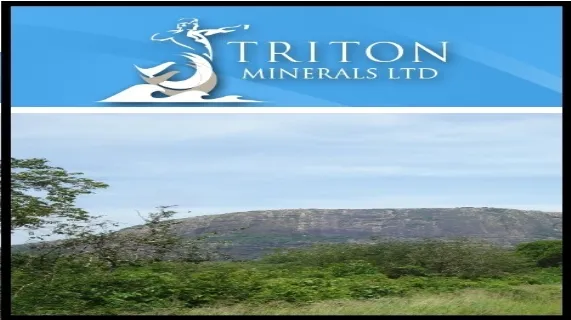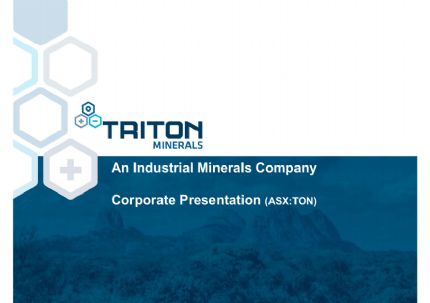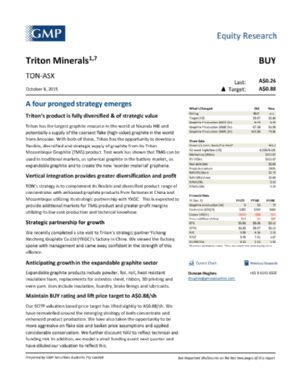
Extraordinary Metallurgical Results - Ancuabe Project
Perth, April 29, 2015 AEST (ABN Newswire) - Triton Minerals Limited ( ASX:TON) (Triton, Company) is pleased to confirm receipt of further assays and particle size distribution results for the Ancuabe prospect.
ASX:TON) (Triton, Company) is pleased to confirm receipt of further assays and particle size distribution results for the Ancuabe prospect.
- Additional metallurgical investigations confirm the substantial presence of large particle size (>590µm) up to 3350µm (in excess of 6 mesh) in the Ancuabe samples.
- Flotation tests confirm 92% of the discrete mass particles in the samples were larger than 150µm (+100 mesh).
- Total graphitic carbon ("TGC") recovery of up to 96.1% in the rougher flotation.
- Graphitic carbon grades of 96.4% achieved in the primary cleaner at a yield of 15.1% and recovery of 91.0%.
- Graphite concentrate grade of 98.7% TGC was achieved after single bead mill regrind and four cleaner stages.
- Highest head grade of 24% TGC occurs in the -600+425µm size fraction.
- The graphite is readily liberated by crushing, grinding, rougher and cleaner flotation, with no additional regrind required.
- Further tests to optimize the graphite flake recovery process are continuing.
Triton Minerals' Managing Director & CEO Brad Boyle said: "Triton is extremely pleased to announce that an initial sighter test of Ancuabe bulk sample material that at the very least, has produced positive and encouraging metallurgical results.
However, these early results are, in my opinion, quite extraordinary and bode well for establishing a new benchmark for the highest quality graphite products available from Mozambique.
The tests confirm grades of up to 98.7% TGC after only 4 cleaner stages after a single bead mill regrind. Achieving such high grades and recoveries at very coarse particle sizes with a yield or mass pull of only 15% has very positive implications for potential downstream economics.
Due to the high graphite grades of around 98% TGC, which were obtained in just two minutes of flotation, we can safely assume that the particles comprises dominantly graphite flake. The concentrate flake size distribution data will be forthcoming shortly.
These results support the concurrent advancement of the Ancuabe project which is expected to provide Triton with the ability to provide greater flexibility in the range of TMG products, for a wide range of clients, this would place Triton in an extremely unique and advantageous position in comparison to its peers."
Metallurgical Results Recovers Jumbo Graphite Flakes
Initial mineralogical and metallurgical test work on the Ancuabe sample by Mintek (Johannesburg) confirms the strong presence and recovery of jumbo graphite flakes, including graphite flakes in excess of 3mm being identified during the flotation process.
Mintek flotation tests and feed particle size distribution results confirms 92% of the graphitic particles in the samples were larger than 150µm including:
- 86% larger than 177µm (+80 mesh)
- 73% larger than 300µm (+50 mesh)
- 46% larger than 590µm (+32 mesh)
- 20% larger than 850 µm (+20 mesh)
Micron Mesh Discrete Mass (%) Grade (%TGC) >590 32 46.0 98.1 >300 50 26.6 97.0 >177 80 13.4 95.1 >150 100 6.0 94.0 >75 200 8.0 92.7Table 1. Ancuabe - size by assay of flotation feed (target 80% - 850µ)
The confirmation of the very large size fractions of high graphite grade recovered from flotation is consistent with the mineralogical observations and is considered an extremely positive result for Triton, with potentially positive economic implications.
These outstanding results have been obtained from the rougher stages only, in a flotation testing program undertaken at the Mintek Laboratories on the 100kg sample.
Triton confirms the preliminary metallurgical results shows the total carbon ("TC") recovery of 96.1% in the rougher flotation of the Ancuabe samples. A primary cleaner grade of 96.4%TGC was achieved.
Prior to the flotation process the initial average measured graphite head grade for the Ancuabe samples was 14.4% TGC. Triton notes that with limited processing graphite head grades were upgraded to an average of 15.8% TGC. Further, the results show the graphite grades in the partial size range of the 300µm -1180µm substantially exceed the overall average graphite head grade (Figure 2 in link below).
These results confirm the high value potential of the Ancuabe project, with high graphite grades of up to 24%TGC obtained and the majority of the partial sizes contained within the jumbo and super jumbo flake range, any graphite concentrate produced in this partial size range is likely to sell for in excess of US$2,000 or more per tonne. The combination of high graphite grades and jumbo graphite flakes would provide very strong economics of any future graphite production at the Ancuabe project.
The very high graphite grades were obtained through the standard methods of crushing, grinding, rougher and cleaner flotation, without the need to complete a regrind of the graphite concentrate and demonstrates how readily the graphite flakes can be separated during the flotation process, which are strong indicators of the high quality nature of the Ancuabe project. The reduced processing requirements during the graphite flotation will likely have a positive impact for Triton reducing the time and energy needed to complete the process.
Ongoing optimization of the metallurgical process is expected to further enhance the quality of the final product concentrate. The Company is also reviewing options to see if the graphite concentrate can be further upgraded using supplementary treatments.
Triton considers these initial results to be an encouraging outcome, and are consistent with results from the first crush as announced by the Company on 26 February 2015. These flotation tests confirm the majority of the graphite can be liberated cleanly from the surrounding gangue material during the initial crushing, without the need for additional processing.
Triton notes that the liberation of a large portion of the graphite flakes by crushing only, significantly reduces the time and cost of extraction whilst achieving the preservation of the larger flake size fractions. The Company is optimistic of further encouraging results with the completion of additional metallurgical test work.
CONCLUSIONS
The latest metallurgical results from Ancuabe confirms the very high quality nature of the Ancuabe graphite project and signify positive implications for potential downstream economics.
Should Triton be able to demonstrate production of economic quantities of large and jumbo flake graphite at Ancuabe, it could complement the TMG products range and provide the Company with the potential to produce large volumes of high grade (high value) graphite in the full range of flake sizes, thereby accommodating a wider range of end-user requirements.
To view tables and figures, please visit:
http://media.abnnewswire.net/media/en/docs/ASX-TON-717225.pdf
About Triton Minerals Ltd
 Triton Minerals Limited (ASX:TON) is an ASX listed, responsible mineral explorer and resource management company headquartered in Perth, Australia.
Triton Minerals Limited (ASX:TON) is an ASX listed, responsible mineral explorer and resource management company headquartered in Perth, Australia.
Led by a highly experienced management team, Triton Minerals' vision is to grow shareholder's value through discovery or development of base metal, gold and other precious metal deposits.
Triton has made excellent progress with its three Graphite projects located in the Cabo Delgado Province in Mozambique, with the program successfully identifying a number of graphitic exposures.
It is the Company's belief that the Mozambique, Balama North Project could host multiple and very substantial world class graphite deposits.
| ||
|







